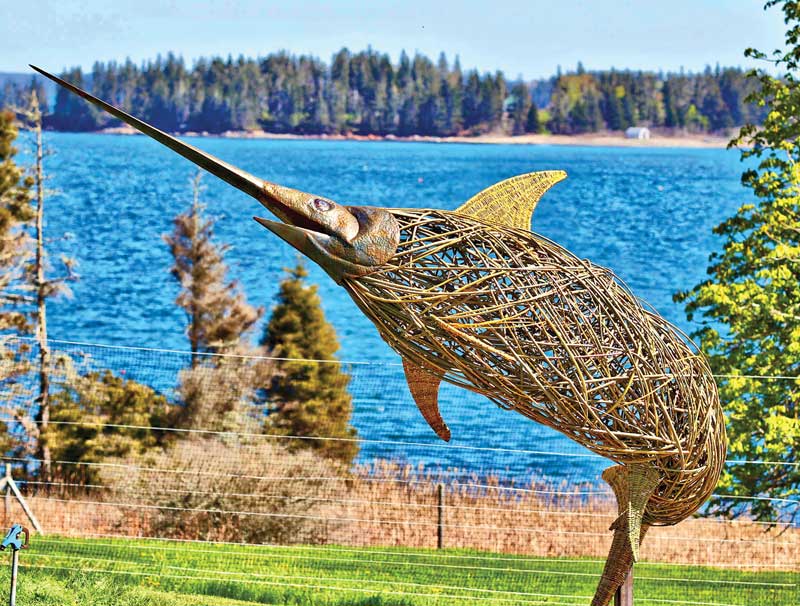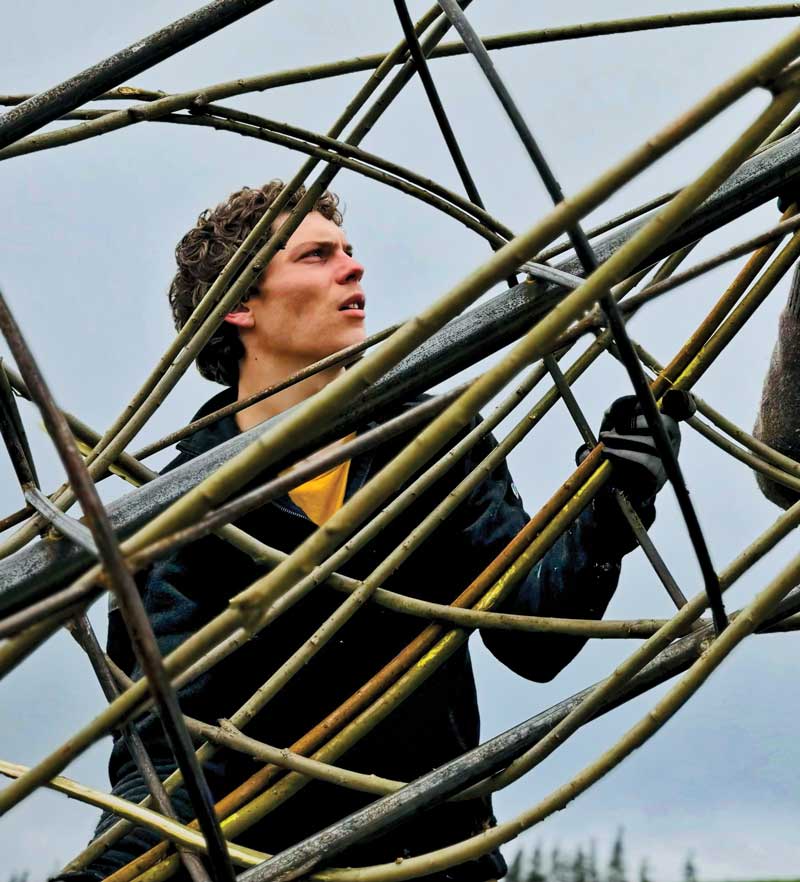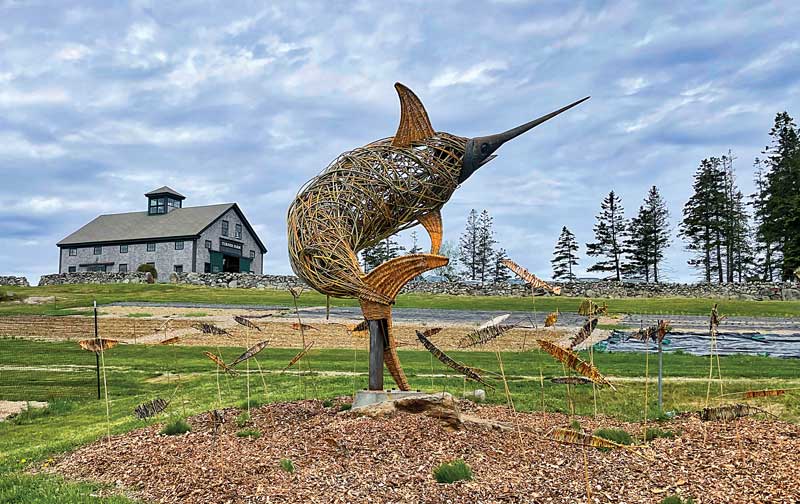 The swordfish overlooks the Turner Farm shell midden, in which archaeologists have found evidence of thousands of years of habitation by the Penobscot people and their ancestors, who hunted swordfish from the beach. Photo by Scott Gilbert
The swordfish overlooks the Turner Farm shell midden, in which archaeologists have found evidence of thousands of years of habitation by the Penobscot people and their ancestors, who hunted swordfish from the beach. Photo by Scott Gilbert
The swordfish arcs across the sky, smaller fish dancing in its wake. Penobscot Bay gleams at its back and rows of lettuce and artichokes spread out at its sides. Bigger than anything that swam the seas, even in the ancient past, Billy Ray Sims and Ann McClellan’s 21-foot steel armature and willow sculpture graces the field at Turner Farm, inviting conversation and connecting past and present.
“Our general concept was to build a largescale piece of land art with community involvement,” Sims said. A basket maker whose studio is in Camden, Sims originally imagined a whale sculpture sited on North Haven Conservation Partners land, but he and McClellan, a ceramicist and Sims’s creative collaborator and studio partner, realized a swordfish connected more authentically to North Haven’s history. From there, a partnership with Turner Farm was only natural.
Turner Farm is home to a shell midden, one of the oldest surviving sites on the Atlantic Coast. Excavations led by archaeologist Bruce Bourque between 1971 and 1980 revealed thousands of years of occupation by the ancestors of the Penobscot Nation, sometimes referred to as the Red Paint People, on North Haven, as evidenced by bone, stone, and pottery fragments, and remnants of dwellings. One of the most important findings, according to Bourque’s overview on the Turner Farm website, were swordfish remains and tools used to hunt swordfish.
“It’s a tribute to the people who were here before,” Sims said. “We’re building a bridge between the island community and the Penobscot community.”
Sims and McClellan recognized the importance of involving Penobscot cultural affairs and historic preservation experts early in the process. They reached out to tribal historian James Francis and archaeologist Chris Sockalexis, the Penobscot Nation’s tribal historic preservation officer.
“I thought it was an amazing project,” Sockalexis said. “My ancestors were hunting swordfish in the bay 5,000, 6,000 years ago. Turner Farm is a significant archaeological site from the Maritime Archaic time period,” which was marked by lifestyle and dietary transitions from solely terrestrial animals to a greater reliance on the rivers and the sea for sustenance. “This was a great way to get that story out.”
 North Haven Community School senior Bryn Campbell weaves willow branches into the swordfish’s metal armature. Photo by Alix MartinCommunity involvement, particularly from students at North Haven Community School and the North Haven Historical Society, was an essential part of the concept for Sims and McClellan. A chance meeting with secondary art teacher Alix Martin on the ferry offered an inroad, once Martin was reassured that the project was supported by Sockalexis. The steel armature, which was constructed by Tom Hardy at Rockport Steel from Sims and McClellan’s plans, was installed at Turner Farm in early May, and some of Martin’s high school art students were involved in weaving willow branches from Richard Frost’s farm in Liberty into the armature. Middle school students and community members, including Rep. Chellie Pingree, also contributed, and a group of visiting basket makers from Kentucky wove the swordfish fins with basket willows. Younger students involved in the school’s project-based curriculum wove the smaller fish, also from willow. These were installed at the base of the sculpture and add a movement element when the wind blows up from the bay.
North Haven Community School senior Bryn Campbell weaves willow branches into the swordfish’s metal armature. Photo by Alix MartinCommunity involvement, particularly from students at North Haven Community School and the North Haven Historical Society, was an essential part of the concept for Sims and McClellan. A chance meeting with secondary art teacher Alix Martin on the ferry offered an inroad, once Martin was reassured that the project was supported by Sockalexis. The steel armature, which was constructed by Tom Hardy at Rockport Steel from Sims and McClellan’s plans, was installed at Turner Farm in early May, and some of Martin’s high school art students were involved in weaving willow branches from Richard Frost’s farm in Liberty into the armature. Middle school students and community members, including Rep. Chellie Pingree, also contributed, and a group of visiting basket makers from Kentucky wove the swordfish fins with basket willows. Younger students involved in the school’s project-based curriculum wove the smaller fish, also from willow. These were installed at the base of the sculpture and add a movement element when the wind blows up from the bay.
The swordfish sculpture was unveiled at an event hosted by the North Haven Historical Society on May 18, 2024. The attendees included nearly 100 fishermen, artists, historical society representatives, and curious islanders. Sockalexis sang an honor song for his ancestors buried at Turner Farm, then gave a presentation about the archaeology of the shell midden and the surrounding area. Author and retired swordboat captain Linda Greenlaw spoke as well, focusing on the contemporary swordfishing industry.
Sims and McClellan plan to leave the swordfish installed at Turner Farm at least through next summer, although they know the natural materials involved in the piece open the door for a little uncertainty. The willow branches have already gained a natural patina, darkening from gold to a rich brown from exposure to the sun, wind, and sea air.
 Smaller woven-willow fish, created by North Haven Community School students, surround the main sculpture. Photo by Ted Ruegg
Smaller woven-willow fish, created by North Haven Community School students, surround the main sculpture. Photo by Ted Ruegg
“We want anyone who visits here to understand the relevance to local history, the importance to the community and to the place,” Sims said. “Perspective.” Plans are in the works for interpretive signage to more explicitly connect the sculpture to Penobscot history.
Visitors to the farm are already engaging with the sculpture, according to farm manager Benjamin White, who observes them shifting their own perspective to view it from different angles, seeing how it changes their experience of North Haven.
✮
Courtney Naliboff is a writer, educator, and musician on North Haven island. Her first book, Your Postpartum Body: The Complete Guide to Healing After Pregnancy, was released in June 2024.
For More Information
Read about the diversified organic farm’s offerings, from barn suppers to event rentals at turner-farm.com.






